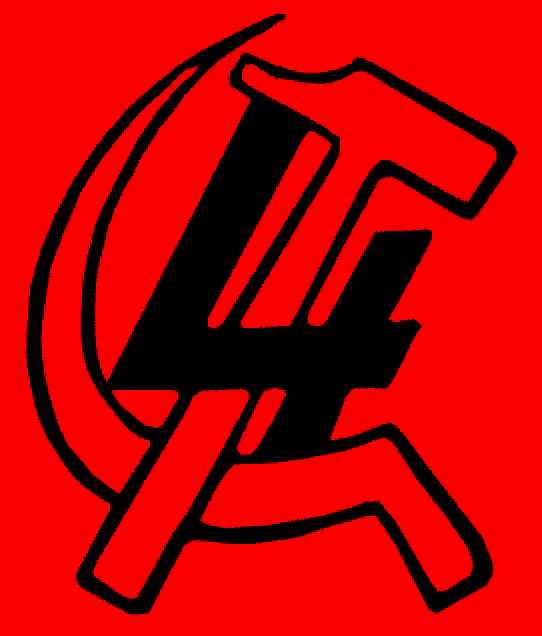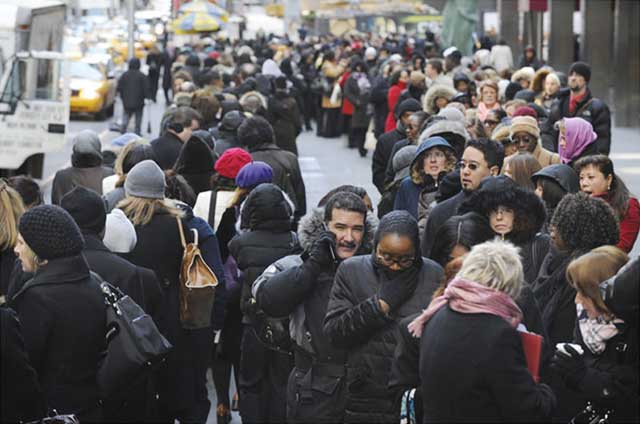
March 2009
World Capitalism Plunges

Hundreds of job seekers line up in Manhattan, February 2000. (Photo: Casey Kelbaugh for The New York Times)
19 MARCH 2009 – The global economic crisis continues to deepen, month after month. With the financial crisis that exploded in September 2008, the international credit system effectively froze, making it virtually impossible for even the largest firms with the best ratings to obtain new loans. In what amounts to a slow-motion stock market crash, values on financial exchanges worldwide have have been cut in half from their 2007 highs. Since then, the plunge has moved from the realm of what Karl Marx called “fictitious capital” to the real economy. In the past five months, there has been a sharp drop in industrial production, investments, exports, consumer spending, construction and just about every other major indicator of economic activity in virtually every country of the capitalist world. This marks a big difference from all other recent economic crises, where countries could recover by exporting to other markets (notably the United States) or pouring money into new speculative bubbles. Not this time.
Although attention has been focused on the financial crisis – and on the Wall Street bankers, hedge fund operators insurance company execs who have made out like bandits – the economic downturn began almost a year earlier. In the U.S, this is already be the longest recession since World War II, and it’s not ending any time soon. Housing prices fell by 20 percent last year in major markets and 10 percent of all mortgages are in arrears or default; 19 million houses and apartments are standing empty around the country, while homelessness increases. More than 4.4 million jobs have been lost so far, 650,000 in each of the last three months. While the official unemployment rate is at 8.1 percent, the actual rate is considerably higher (the government fudges the statistics by not counting those who have given up looking for work). The broader unemployment count is now 14.8 percent of the workforce, and it’s heading a lot higher. Consumer spending has gone through the floor, especially for big ticket items like automobiles (down 41 percent in February).
One economist quipped that not so long ago people were buying cars, big screen TVs and refrigerators like they were groceries; now they are buying groceries like they are cars. Just as in the 1930s farmers dumped “surplus” milk while people went hungry, today sales of dairy products have dropped so far that there is an “oversupply” of cows so farmers are selling off (and killing off) their herds! Another sign of the times: General Electric, which was considered the gold standard of blue chip stocks because it paid a dividend straight through the 1930s, announced at the end of February it was cutting its dividend by two-thirds. One anguished retiree wrote in response: “We are retired. My husband is 90 1/2 and is not to proud to eat the food I will have to now get us dumpster diving. We needed that dividend for food.”
Recession or Depression? Suddenly the rulers are beginning to mention the dreaded “D-word.” Bourgeois economists have described recent recessions as “V-shaped,” with a sharp decline followed by sharp upturns. They at first said the current crisis looked like a “U-shaped” recession, lasting longer at the bottom before turning up. Now quite a few are saying that this crisis will be “L-shaped”: plunging straight down, and staying there. The CEO of Microsoft, Steve Ballmer, said in announcing 5,000 layoffs, the first significant cuts ever for the computer giant: “Our model is not for a quick rebound. Our model is things go down, and then they reset. The economy shrinks” (New York Times, 23 January). Or as John Silvia, chief economist at Wachovia Bank, put it (New York Times, 7 March):
“These jobs aren’t coming back.... A lot of production either isn’t going to happen at all, or it’s going to happen somewhere other than the United States. There are going to be fewer stores, fewer factories, fewer financial services operations. Firms are making strategic decisions that they don’t want to be in their businesses.”
What is to be done? In short, the recession is rapidly becoming a depression, although the capitalist rulers don’t want to say so because they fear that would set off an even worse panic. Generally, “mainstream” economists say a depression (which they used to claim was no longer possible) is just a worse recession. But there is a significant difference. The series of recessions every 5-7 years that one can find at any point in the history of capitalism is an expression of the cyclical nature of the production for profit system. However, when production remains stuck at severely depressed levels for years this is not cyclical but the result of a crisis of the capitalist system itself. In the 1930s, economist John Maynard Keynes analyzed that the economy was caught in a “liquidity trap,” so that governments had to inject large amounts of money to get production going again. It is now admitted even by bourgeois economists that this was insufficient and only World War II put an end to the Great Depression of the ’30s.
The recipe of the monetarist “free market” economists for dealing with an economic downturn was to lower interest rates. Federal Reserve chairman Ben Bernanke tried that, driving down interest rates to near zero percent, but the banks wouldn’t lend. Bush’s Treasury Secretary Henry Paulson then tried giving away vast amounts of dollars to the bankers (the $750 billion “bailout”), but they just put the money in their reserves (or gave themselves bonuses). Even free money wouldn’t restart the stalled economic engine. Now Obama is trying the standard Keynesian answer, to pump cash into the economy through public works in the $825 billion “stimulus” bill. But that will only have a limited impact as well, and unemployment will keep soaring. It won’t work because it assumes that the basic problem of the economy is underconsumption: give the people more money, they will buy more, companies will produce more, banks will lend more, etc. But the problem that set off the crisis isn’t that people weren’t consuming – on the contrary, egged on by the banks and credit card companies, American consumers were busy spending money they didn’t have, sinking into debt.
The underlying issue behind both the waves of financial speculation and now the sharp drop in the real economy is the overproduction of capital, and therefore of goods, and the associated falling rate of profit. The rate of real capital formation in the advanced capitalist countries has been extremely low since the late 1980s because investors figure they can’t get a sufficient rate of return on their capital investing in production. So instead they “invest” it in stock market speculation, information technology or housing bubbles, and when those burst they just sit on the cash. Building highways or “green” energy projects won’t change that, the “multiplier effect” of deficit spending will be minimal. Under capitalism, the only way the rate of profit can be restored is through the destruction of capital, by massive bankruptcies producing millions of unemployed, or by imperialist war laying waste to productive capacity. Or, as happened in the 1930s and ’40s, by both. After the bloodbath is over and a “reasonable” profit rate restored, the production cycle will resume ... at a cost of untold mass misery.
The present global capitalist economic crisis is not cyclical or even structural but systemic. Neither monetarists nor Keynesians can solve it. But as Lenin and Trotsky insisted, capitalism will not collapse of its own accord. The capitalist answer to a crisis of overproduction is barbarism: the imperialist war mongers will try to shoot their way out of the mess the capitalists have created. The only way to defend the very existence of the proletariat today is by mobilizing our class power to demand what we need. A series of transitional demands should be raised pointing to the need bring down the bourgeoisie and institute workers rule (see “Exchange on Transitional Demands”). That centrally requires breaking the stranglehold of the capitalist parties and building a workers party that fights for international socialist revolution, which can lay the basis for a planned economy producing to fulfill human needs rather than profit. ■
To contact the Internationalist Group and the League for the Fourth International, send e-mail to: internationalistgroup@msn.com